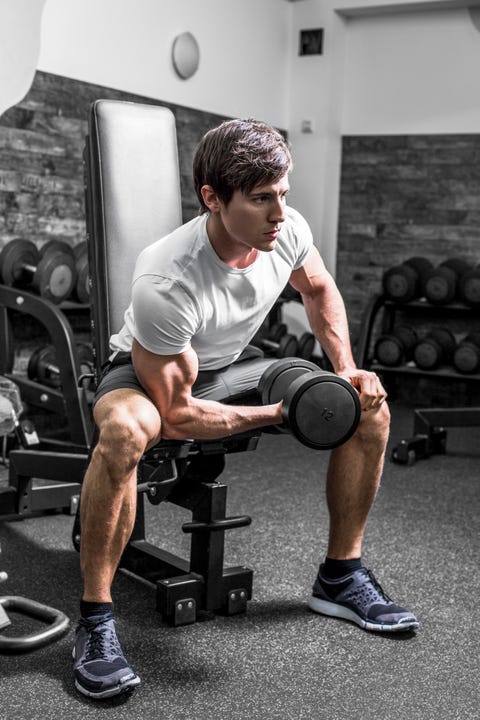3 Supersets that can Smash Your Entire Body
Back. Biceps. Chest. Triceps. Shoulders. Abs. And those are just a few of the major bodyparts that you likely want to train when you settle into a workout.
So how on earth do you hit every single bodypart every week, especially if you really want to hammer each muscle? Spend six hours a day working out? Train seven days a week? Two-a-days?
Sure, you could try all those approaches, and you’d probably see success with them, too. Or you could explore what just may be the most time-efficient methods of handling classic strength-building exercises, the superset.
Here’s the beauty of a superset: It maximizes your time. If you’re aiming to build strength, rest between sets is key, and normally, that means a lot of dead time in your workout. Let’s say your bench-pressing. You may take 60 to 90 seconds between four sets of work. During those 60 to 90 seconds, you’re catching your breath, not lifting weights.
When you superset, you’d spend those 60 to 90 seconds of rest doing a different exercise, ideally one for an opposing muscle group. That might lead you to, say, dumbbell rows or incline rows. Your chest, the prime mover during the bench press, is still getting the “rest” it needs, while the rest of your body, led by your back muscles, is working.
It’s a smart, efficient way to train, and it has some advantages too.
Why Supersets Work
Supersets are a terrific tool for multiple reasons. First off, you’re being time-efficient, using your rest period to train another bodypart. That means less rest time overall, which means a faster workout, and more than that, too. Since you’re resting less frequently, you’ll also be keeping your heart rate elevated more consistently throughout the workout, training your cardiovascular system more than you might expect. This is especially useful if you’re stuck in the house without gym access; if you can’t lift quite as much weight as you would at the gym, you can at least train more intensely with supersets.
Additionally, supersets very often allow you to train your body with balance, because you’re supersetting two different bodyparts. This can help you build a better physique, and a more durable one too. One of the downfalls of training just one bodypart a day is this: It becomes easy to train certain bodyparts more than others.
Supersets help keep you accountable to building a balanced body, because you might superset, say, a chest exercise and a back exercise. That insures that both bodyparts are getting attacked. That’s especially critical to your long-term health, because many gym injuries occur due to muscle imbalances. Over-train your chest, for example, while rarely training back, and tight pecs will pull your shoulders forward, closing down joint space and leading to shoulder injuries. Train chest and back at once with supersets, and you’re helping to avoid that.
Common Supersets

Westend61Getty Images
The key to supersets is how you create proper pairings. You shouldn’t randomly marry exercises to each other, because that’s not going to achieve everything. For example, supersetting a shoulder press with a calf raise isn’t going to achieve anything.
Ideally, you want to aim to superset opposing muscle groups and motions. That insures that you train your entire body evenly, and it’ll help you build total-body strength and muscle. Keep these supersets in mind.
Back-and-chest: When you do, say, a bench press or a pushup, you’re pushing something away from your torso. The opposing motion has you pulling something toward your torso, as you do in a row. This is one of the safest supersets out there.
Biceps-and-triceps: Doing an exercise for biceps emphasizing flexing your arm at the elbow and hits the front of the upper arm. Meanwhile, you straighten your arms with your triceps, emphasizing the back of the arm. This pairing has an added bonus: It’ll keep constant bloodflow in your arms, meaning a constant supply of nutrients from the muscles you’re aiming to train.
Hinge-and-squat: Pairing a hinge motion, like a deadlift, with a squat motion insures that you’re attacking your legs with aggression. The squat motion, whether it’s a goblet squat, front squat, or bodyweight squat, will always emphasize your quads slightly more than the hinge motion, which is typically meant to stimulate hamstrings and glutes. Even better, both movements challenge your total body more than you think, leading to greater calorie burn and total body muscle development.
Mental Focus
If there’s a downfall to the superset, it’s this: It relies on the user to stay ultra-focused for a long period of time. Very often, people do the first exercise in the superset with aggression, then go through the motions on the second. Don’t do that. Stay focused on the entire superset so you get the most out of it.
Your Superset Workout
Directions: Do 3 sets of each pair of exercises, doing the first move, then immediately doing the second move, then taking a 60-second break. Do this workout up to three times a week, resting at least one day between sessions.
Superset 1
Incline Dumbbell Row: Do 10 to 12 total reps, focusing on squeezing your mid-back.
Dumbbell Bench Press: Do 10 to 12 total reps.
Superset 2
Goblet Squat: Do 10 to 12 reps. You can use a kettlebell, dumbbell, or a gallon of water if you can’t find any weights.
Dumbbell Romanian Deadlift: Do 8 to 10 reps. Don’t have a barbell or dumbbells? Lift a heavy box.
Superset 3
Dumbbell Biceps Curl: Do 10 to 12 reps.
[mediaosvideo align=’center’ embedId=’3edba4f0-f0dc-4ce2-8ee9-9dd34e5f9423′ mediaId=’e9cda07b-7fbe-45b6-81cd-8e82773ccab7′ size=’large’][/mediaosvideo]
Dumbbell Skullcrusher: Do 10 to 12 reps.
Source: Read Full Article


